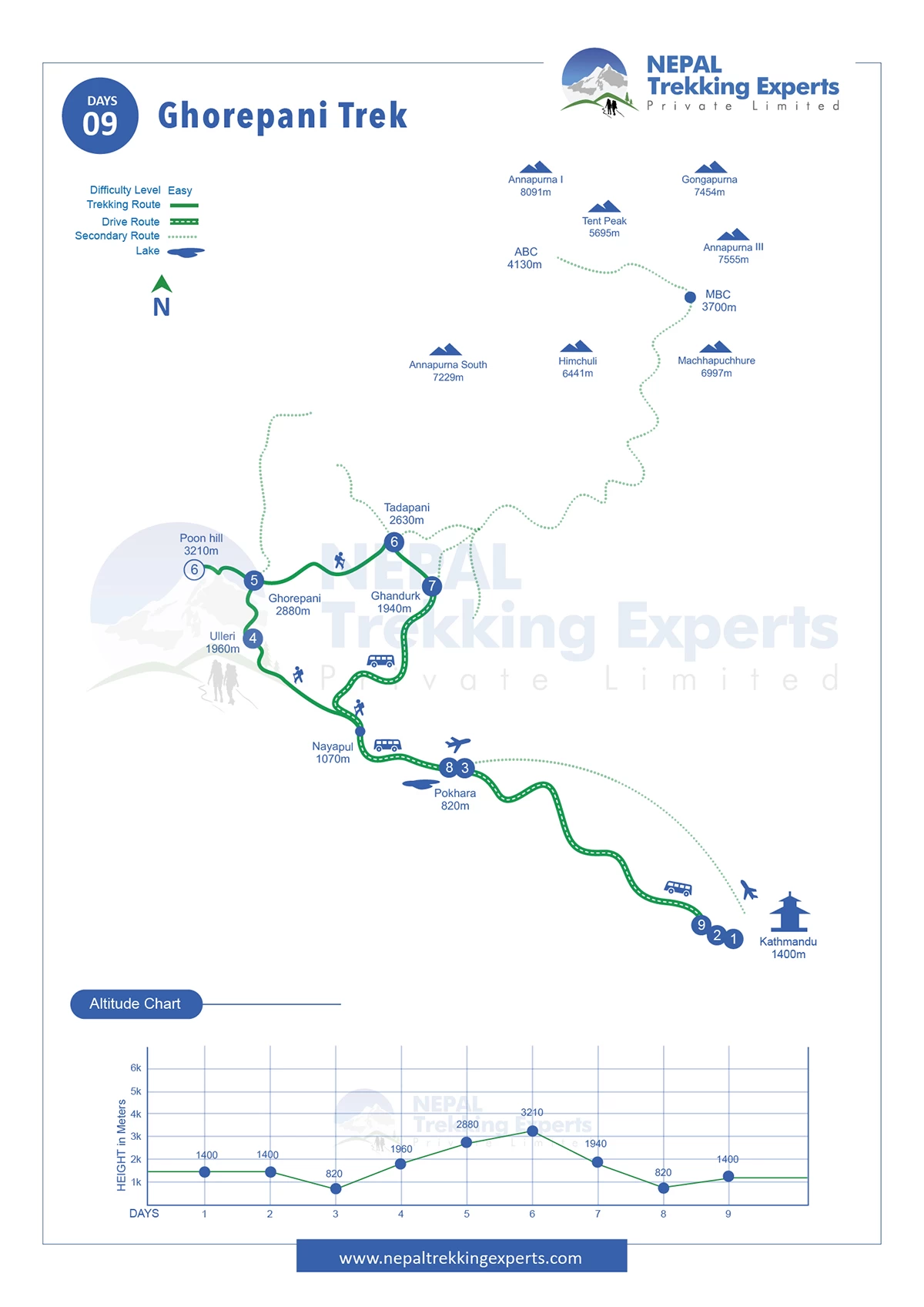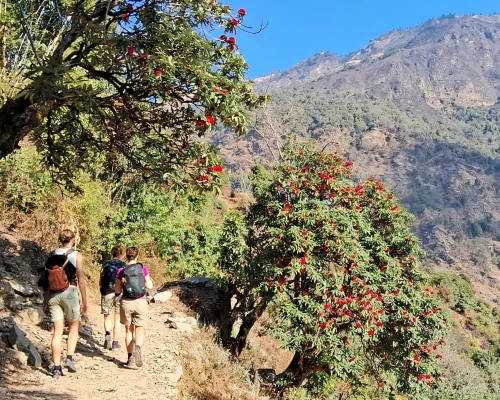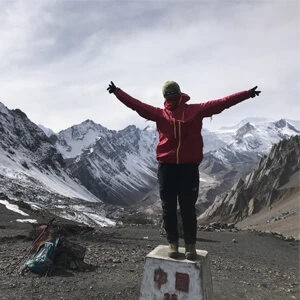Tips For A Successful Ghorepani Scenic Trek
- Although the trek is not extremely difficult, it's still important to have a basic level of fitness.
- Even though the trek reaches a modest altitude of 3,210 meters (Poon Hill), altitude sickness can still affect some trekkers.
- Pace yourself by taking short breaks during the trek, especially during the uphill sections.
- Dress in layers to adjust to changing temperatures throughout the day.
- While the trek is popular, it’s still important to practice responsible trekking.
- Carry a basic first aid kit with items like band-aids, blister treatment, and any personal medications.
Accommodation During The Poon Hill Viewpoint Trek
There are plenty of tea houses to choose from in the famous Annapurna region of Nepal, so there's no need to carry camping or cooking supplies. The Annapurna routes are well-loved and well-traveled, meaning that tea houses ranging in quality have been established to meet the range of needs of travelers. At lower elevations and busier areas, you can choose more fully equipped tea houses with electricity, wifi, and en suite bathrooms with hot showers and western toilets. At these tea houses, you can pay a small fee for services such as wifi and hot showers. We provide you with a clean, negative 10°C sleeping bag to keep you cozy and warm.
Meals During The Poon Hill Viewpoint Trek
There are plenty of tea houses to choose from in the famous Annapurna region of Nepal, so there's no need to carry camping or cooking supplies. The Annapurna routes are well-loved and well-traveled, meaning that tea houses ranging in quality have been established to meet the range of needs of travelers. At lower elevations and busier areas, you can choose more fully equipped tea houses with electricity, Wi-Fi, and en suite bathrooms with hot showers and western toilets. There are also more rustic, basic community homestays (the money that you spend goes to the local community) and tea houses available, especially at higher elevations, that have simple rooms and basic services. Bathrooms might be shared and have a squat-style toilet. At these tea houses, you can pay a small fee for services such as Wi-Fi and hot showers. We provide you with a clean, negative 10°C sleeping bag to keep you cozy and warm.
Transportation To The Ghorepani Hill Trek
All transportation fees and arrangements are included in your trekking package when you book with Nepal Trekking Experts. To start your adventure on the Ghorepani Poon Hill Trek, there are many transport options depending on your interest (by flight, by car, jeep, van, or tourist bus), time frame, and budget. A common route is to travel via tourist bus from Kathmandu (Sohrakhutte) to Pokhara (normally 7 hours, but it takes 10 hours now due to road construction and poor road conditions, which are already included in the package). If you take a flight, it takes 20 minutes. Common starting points include Nayapul, Hile, Tikhedhunga, or Ulleri by taxi or jeep. The further you travel via Jeep, the less trekking you'll do by foot.
Bus rides can be part of the exciting, immersive experience of being in a foreign country, but they are not for everyone. If you would like a more comfortable alternative, we can arrange a private car, Jeep, or flight from Kathmandu to Pokhara. Private transportation shortens your travel time considerably, and you can stop for breaks at your leisure. With so many travel options, we'd be happy to talk things through with you to find what suits you best.
Battery Charging, Telephone Service, Internet During The Poon Hill Family Trek
Battery Charging
Despite trekking deep into the Himalayas, most of the tea houses have either electricity or solar power. Depending on the tea house, you might be able to charge your devices in your rooms. Otherwise, you can pay a few dollars (paid in local rupees) to charge your battery in the main dining hall. Carrying a power bank is recommended during your trek in the Khopra region.
Telephone Service
Nowadays, most villages have phone service and mobile reception, although it can be quite unpredictable. NCELL and Nepal Telecom are the two major SIM card providers. Nepal Telecom is recommended by the NTE for better reception in the Annapurna region. You can purchase a SIM card in Kathmandu when you arrive.
Internet
Many tea houses have wifi to purchase for around 2-3 dollars per night, which is paid in local Nepali rupees. Please be aware that internet services may not be completely reliable due to weather and other issues.
Porter
Our tailor-made packages do not include a porter, so you can make the decision based on your own needs and preferences. Although not necessary, having a porter can make a massive difference in the enjoyment of your trek. If you are new to trekking at high altitudes, then we would recommend having a porter in the Annapurna region carry your bag across the rugged terrain. One porter carries the bags of two people (around 20kg) so that you can carry a small daypack. If you are undecided, we would be happy to discuss porters in more detail when you book your trek or on arrival in Kathmandu.
Ghorepani Village Trekking Gear Checklist
Clothing
- Raincoat, poncho, or combination jacket/trousers
- One-down jacket/Gore-Tex jacket
- Two pairs of hiking pants (depending on the duration of the trek)
- One pair of shorts
- Three or four T-shirts (depending on the duration of the trek)
- One MIT/fleece jacket
- One pair of base layers (merino wool or similar thermal ware)
- Three to four pairs of hiking socks
- A pair of waterproof or windproof gloves
- Undergarments
Footwear
- Trekking boots (water resistance, ankle support)
- Flip-flops for leisure time around camp or one pair of sneakers
Other equipment
- Sunglass, sunscreen, lip balm, sun hat, woolen/fleece hat/beanie, neck gaiter, first aid kit, Swiss army knife (optional), luggage cover, headlamp, trekking poles, water purification tablets or steripen, extra batteries, adapter, power bank, water bottles/camel bags/thermos, washing powder/multi-purpose soap, shampoo, a small towel, antiseptic hand wash, toiletries, female hygiene products, wet wipes, mosquito spray (optional), whistle, earplugs, reading books, playing cards/chess
- Sleeping bag rating: -5 degrees Celsius extreme temperature depending on trekking season
- Backpack (60 liters)
- Daypack (25 to 30 liters)
Travel Insurance
It is one of the most important things you'll need overseas, particularly when trekking in Nepal. A policy that covers loss and theft, medical and hospitalization, evacuation from high altitude, and adventure activity coverage are among the basics you'll need. A wide variety of policies are available, so make sure to shop for the best possible options. You need to have a policy that's specific to the maximum height on your trek, bearing in mind that several companies place restrictions on that score—look closely at the fine print so that you're sure to get the right coverage, especially in the event of an emergency such as altitude sickness—helicopter evacuations are horrendously expensive.
Also note that most medical treatment and facilities in Nepal, such as hospitals, require payment upfront or approval from your insurance company, so it’s wise to choose a policy that pays the bills directly rather than lumping the burden on you and leaving it till later for the insurer to reimburse you.
Nepalese Currency And Payment
The currency of Nepal is the rupee. The ideal currencies for exchange are those of the USA, Australia, Great Britain, Canada, and Singapore, as well as the Euro, any of which can be readily exchanged in either Kathmandu or Pokhara.
Credit and debit cards such as Visa, MasterCard, and American Express are accepted in major tourist-class hotels, restaurants, airlines, and larger stores in Kathmandu, Bhaktapur, Patan, Pokhara, etc. A surcharge of 3.5% is typically levied on all purchases or payments.
ATMs are also very common in Kathmandu and Pokhara, with Thamel being a particular area of focus for their use. Some ATMs only allow a daily maximum of Rs 20, 000 to be withdrawn, while others allow for as much as Rs 35, 000. A charge of USD 4 is usually applied per transaction, on top of which your bank may also apply a fee of its own.
Can I get an on-arrival visa in Nepal?
On arrival in Nepal, you can obtain the requisite visa at Tribhuwan International Airport (TIA) in Kathmandu, or you can choose the alternative of applying for it at the Nepalese Embassy or Consulate in your home country before departure. The visa is also available at land-based points of entry such as Birgunj, Kakarbhitta, Bhairawa, Belhiya, Nepalgunj, Dhangadi, and Mahendranagar. The Kodari Pass is the access point from Tibet where the visa can be obtained.
While you can use different modes of payment at the visa fee counter, we advise you to bring cash in the following currencies: US dollars, euros, Swiss francs, pound sterling, Australian dollars, Canadian dollars, Hong Kong dollars, Singapore dollars, and Japanese yen. Credit card payments are also available nowadays.
As per a recent update, the visa fee costs you the following amounts:
- Multiple entries for 15 days—USD 30 or equivalent
- Multiple entries for 30 days—USD 50 or equivalent
- Multiple entries for 90 days—USD 125 or equivalent
- You should also have a minimum of six months of validity remaining on your passport.
- Visa extensions are available from the offices of Nepal Immigration in Kathmandu and Pokhara.
- For more details, please go through the Nepal Immigration website or contact us.







.webp)
 based on 1 review
based on 1 review





